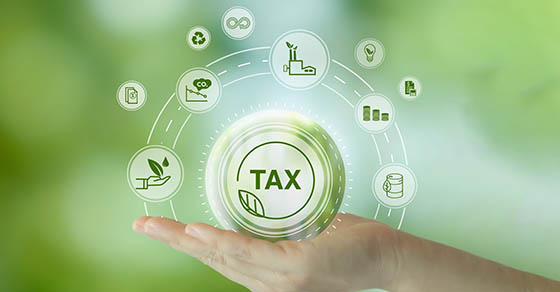
The One Big Beautiful Bill Act (OBBBA), signed into law July 4, 2025, extends or enhances many tax breaks for businesses. But the legislation terminates several business-related clean energy tax incentives earlier than scheduled. For example, the Qualified Commercial Clean Vehicle Credit (Section 45W) had been scheduled to expire after 2032. Under the OBBBA, it’s available only for vehicles that were acquired on or before September 30, 2025. For other clean energy breaks, businesses can still take advantage of them if they act soon.
Deduction for energy-efficient building improvements
The Section 179D deduction allows owners of new or existing commercial buildings to immediately deduct the cost of certain energy-efficient improvements rather than depreciate them over the 39-year period that typically applies. The OBBBA terminates the Sec. 179D deduction for property beginning construction after June 30, 2026.
Besides commercial building owners, eligible taxpayers include:
- Tenants and real estate investment trusts (REITs) that make qualifying improvements, and
- Certain designers — such as architects and engineers — of government-owned buildings and buildings owned by nonprofit organizations, religious organizations, tribal organizations, and nonprofit schools or universities.
The Sec. 179D deduction is available for new construction as well as additions to or renovations of commercial buildings of any size. (Multifamily residential rental buildings that are at least four stories above grade also qualify.) Eligible improvements include depreciable property installed as part of a building’s interior lighting system, HVAC and hot water systems, or the building envelope.
To be eligible, an improvement must be part of a plan designed to reduce annual energy and power costs by at least 25% relative to applicable industry standards, as certified by an independent contractor or licensed engineer. The base deduction is calculated using a sliding scale, ranging from 50 cents per square foot for improvements that achieve 25% energy savings to $1 per square foot for improvements that achieve 50% energy savings.
Projects that meet specific prevailing wage and apprenticeship requirements are eligible for bonus deductions. Such deductions range from $2.50 per square foot for improvements that achieve 25% energy savings to $5 per square foot for improvements that achieve 50% energy savings.
Other clean energy tax breaks for businesses
Here are some additional clean energy breaks affected by the OBBBA:
Alternative Fuel Vehicle Refueling Property Credit (Section 30C). The OBBBA eliminates the credit for property placed in service after June 30, 2026. (The credit had been scheduled to sunset after 2032.) Property that stores or dispenses clean-burning fuel or recharges electric vehicles is eligible. The credit is worth up to $100,000 per item (each charging port, fuel dispenser or storage property).
Clean Electricity Investment Credit (Section 48E) and Clean Electricity Production Credit (Section 45Y). The OBBBA eliminates these tax credits for wind and solar facilities placed in service after 2027, unless construction begins on or before July 4, 2026. Wind and solar projects begun after that date must be put in service by the end of 2027.
Advanced Manufacturing Production Credit (Section 45X). Under the OBBBA, wind energy components won’t qualify for the credit after 2027. The legislation also modifies the credit in other ways. For example, it adds “metallurgical coal” suitable for the production of steel to the list of critical minerals. And, for critical materials other than metallurgical coal, the credit will now phase out from 2031 through 2033. The credit for metallurgical coal expires after 2029.
Act soon
Many of these clean energy breaks are disappearing years earlier than originally scheduled, leaving limited time for businesses to act. If your business has been exploring clean energy investments, now is the time to consider moving forward. We can help you evaluate eligibility, maximize available tax breaks and structure projects to meet applicable requirements before time runs out. Contact us today to discuss what steps you can take to capture tax benefits while they’re available.
If you have employees who travel for business, you know how frustrating it can be to manage reimbursements and the accompanying receipts for meals, hotels and incidentals. To make this process easier, consider using the “high-low” per diem method. Instead of tracking every receipt, your business can reimburse employees using daily rates that are predetermined by the IRS based on whether the destination is a high-cost or low-cost location. This saves time and reduces paperwork while still ensuring compliance. In Notice 2025-54, the IRS announced the high-low per diem rates that became effective October 1, 2025, and apply through September 30, 2026.
How the per diem method works
The per diem method provides fixed travel per diems rather than requiring employees to save every meal receipt or hotel bill. Employees simply need to document the time, place and business purpose of their trip. As long as reimbursements don’t exceed the applicable IRS per diem amounts, they aren’t treated as taxable income to the employee and don’t require income or payroll tax withholding.
Under the high-low method, the IRS establishes an annual flat rate for certain areas with higher costs. All locations within the continental United States that aren’t listed as “high-cost” are automatically considered “low-cost.” The high-low method may be used in lieu of the specific per diem rates for business destinations. Examples of high-cost areas include Boston and Los Angeles. But many locations are considered high-cost during only part of the year. Some of these partial-year locations are resort areas, while others are major cities where costs may be lower for, say, some of the colder months of the year, such as New York City and Chicago.
Under some circumstances — for example, if an employer provides lodging or pays the hotel directly — employees may receive a per diem reimbursement only for their meals and incidental expenses. There’s also a $5 incidental-expenses-only rate for employees who don’t pay or incur meal expenses for a calendar day (or partial day) of travel.
The new high-low per diems
For travel after September 30, 2025, the per diem rate for high-cost areas within the continental United States is $319. This consists of $233 for lodging and $86 for meals and incidental expenses. For all other areas within the continental United States, the per diem rate is $225 for travel after September 30, 2025 ($151 for lodging and $74 for meals and incidental expenses).
For travel during the last three months of 2025, employers must continue to use the same reimbursement method for an employee as they used during the first nine months of the calendar year. Also, note that per diem rates can’t be paid to individuals who own 10% or more of the business.
Revisit reimbursement methods
As the beginning of a new year approaches, it’s a good time to review how your business reimburses employees’ business travel expenses. Switching from an actual expense method to a per diem method in 2026 could save your business and your employees time and frustration. Contact us if you have questions about efficient and tax-compliant travel reimbursement methods.
If you’re considering guaranteeing, or are asked to guarantee, a loan to your closely held corporation, it’s important to understand the potential tax consequences. Acting as a guarantor, endorser or indemnitor means that if the corporation defaults, you could be responsible for repaying the loan. Without planning ahead, you may face unexpected tax implications.
A business bad debt
If you’re compelled to make good on the obligation, the payment of principal or interest in discharge of the obligation generally results in a bad debt deduction. This may be either a business or a nonbusiness bad debt deduction. If it’s a business bad debt, it’s deductible against ordinary income. A business bad debt can be either totally or partly worthless. If it’s a nonbusiness bad debt, it’s deductible as a short-term capital loss, which is subject to certain limitations. A nonbusiness bad debt is deductible only if it’s totally worthless.
To be treated as a business bad debt, the guarantee must be closely related to your trade or business. If the reason for guaranteeing the corporation loan is to protect your job, the guarantee is considered closely related to your trade or business as an employee. But employment must be the dominant motive. If your annual salary exceeds your investment in the corporation, this generally shows that the dominant motive for the guarantee is to protect your job. On the other hand, if your investment in the corporation substantially exceeds your annual salary, that’s evidence that the guarantee is primarily to protect your investment rather than your job.
Proving the relationship
Except in the case of job guarantees, it may be difficult to show the guarantee is closely related to your trade or business. You have to show that the guarantee is related to your business as a promoter, or that the guarantee is related to some other trade or business separately carried on by you.
If the reason for guaranteeing your corporation’s loan isn’t closely related to your trade or business and you’re required to pay off the loan, you can take a nonbusiness bad debt deduction if you show that your reason for the guarantee was to protect your investment, or you entered the guarantee transaction with a profit motive.
Note: The IRS and courts will scrutinize the dominant motive carefully. Reasonable compensation doesn’t always mean money. It can include protecting employment or business interests.
Additional requirements
In addition to satisfying the above requirements, a business or nonbusiness bad debt is deductible only if you meet these three conditions:
- You have a legal duty to make the guaranty payment (although there’s no requirement that a legal action be brought against you).
- The guaranty agreement is entered into before the debt becomes worthless.
- You receive reasonable consideration (not necessarily cash or property) for entering into the guaranty agreement.
Any payment you make on a loan you guaranteed is deductible as a bad debt in the year you make it, unless the agreement (or local law) provides for a right of subrogation against the corporation. If you have this right, or some other right to demand payment from the corporation, you can’t take a bad debt deduction until the rights become partly or totally worthless.
These are only some of the possible tax consequences of guaranteeing a loan to your closely held corporation. Consult with us to learn all the implications and to help ensure the best tax results.
Do you and your spouse together operate a profitable unincorporated small business? If so, you face some challenging tax issues.
The partnership issue
An unincorporated business with your spouse is classified as a partnership for federal income tax purposes, unless you can avoid that treatment. Otherwise, you must file an annual partnership return using Form 1065. In addition, you and your spouse must be issued separate Schedules K-1, which allocate the partnership’s taxable income, deductions and credits between the two of you. This is only the beginning of the unwelcome tax compliance tasks.
The self-employment tax issue
Self-employment (SE) tax is how the government collects Social Security and Medicare taxes from self-employed individuals. For 2025, the SE tax consists of 12.4% Social Security tax on the first $176,100 of net SE income plus 2.9% Medicare tax. Once your 2025 net SE income surpasses the $176,100 ceiling, the Social Security tax component of the SE tax ends. But the 2.9% Medicare tax component continues before increasing to 3.8% — because of the 0.9% additional Medicare tax — if the combined net SE income of a married joint-filing couple exceeds $250,000. (This doesn’t include investment income.)
With your joint Form 1040, you must include a Schedule SE to calculate SE tax on your share of the net SE income passed through to you by your spousal partnership. The return must also include a Schedule SE for your spouse to calculate the tax on your spouse’s share of net SE income passed through to him or her. This can significantly increase your SE tax liability.
For example, let’s say you and your spouse each have net 2025 SE income of $150,000 ($300,000 total) from your profitable 50/50 partnership business. The SE tax on your joint tax return is a whopping $45,900 ($150,000 × 15.3% × 2). That’s on top of regular federal income tax. (However, you do get an income deduction for half of the SE tax.)
Here are three possible tax-saving solutions.
1. Use an IRS-approved method to minimize SE tax in a community property state
Under IRS guidance (Revenue Procedure 2002-69), there’s an exception to the general rule that spouse-run businesses are treated as partnerships. For federal tax purposes, you can treat an unincorporated spousal business in a community property state as a sole proprietorship operated by one of the spouses. By effectively allocating all the net SE income to the proprietor spouse, only the first $176,100 of net SE income is hit with the 12.4% Social Security tax. That can cut your SE tax bill.
2. Convert a spousal partnership into an S corporation and pay modest salaries
If you and your unincorporated spousal business aren’t in a community property state, consider converting the business to S corp status to reduce Social Security and Medicare taxes. That way, only the salaries paid to you and your spouse get hit with the Social Security and Medicare tax, collectively called FICA tax. You can then pay reasonable, but not excessive, salaries to you and your spouse as shareholder-employees while paying out most or all remaining corporate cash flow to yourselves as FICA-tax-free cash distributions. Keep in mind that S corps come with their own compliance obligations.
3. Disband your partnership and hire your spouse as an employee
You can disband the existing spousal partnership and start running the operation as a sole proprietorship operated by one spouse. Then hire the other spouse as an employee of the proprietorship. Pay that spouse a modest cash salary. You must withhold 7.65% from the salary to cover the employee-spouse’s share of the Social Security and Medicare taxes. The proprietorship must also pay 7.65% as the employer’s half of the taxes. However, because the employee-spouse’s salary is modest, the FICA tax will also be modest.
With this strategy, you file only one Schedule SE — for the spouse treated as the proprietor — with your joint tax return. That minimizes the SE tax because no more than $176,100 (for 2025) is exposed to the 12.4% Social Security portion of the SE tax.
Additional bonus: You may be able to provide certain employee benefits to your spouse, such as retirement contributions, which may provide more tax savings.
We can help
Having a profitable unincorporated business with your spouse that’s classified as a partnership for federal income tax purposes can lead to compliance headaches and high SE tax bills. Work with us to identify appropriate tax-saving strategies.
October 1
Trusts and estates: Filing an income tax return for the 2024 calendar year (Form 1041) and paying any tax, interest and penalties due, if an automatic five-and-a-half month extension was filed.
October 10
Individuals: Reporting September tip income, $20 or more, to employers (Form 4070).
October 15
Individuals: Filing a 2024 income tax return (Form 1040 or Form 1040-SR) and paying any tax, interest and penalties due, if an automatic six-month extension was filed (or if an automatic four-month extension was filed by a taxpayer living outside the United States).
Individuals: Making contributions for 2024 to certain existing retirement plans or establishing and contributing to a SEP for 2024, if an automatic six-month extension was filed.
Individuals: Filing a 2024 gift tax return (Form 709) and paying any tax, interest and penalties due, if an automatic six-month extension was filed.
C corporations: Filing a 2024 income tax return (Form 1120) and paying any tax, interest and penalties due, if an automatic six-month extension was filed.
C corporations: Making contributions for 2024 to certain employer-sponsored retirement plans, if an automatic six-month extension was filed.
October 31
Employers: Reporting income tax withholding and FICA taxes for third quarter 2025 (Form 941) and paying any tax due.







